As an Amazon Associate I earn from qualifying purchases.
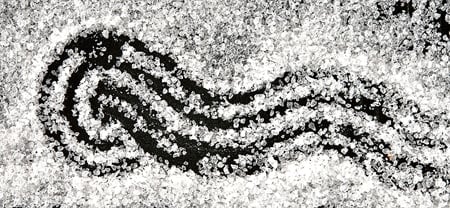
Salt is salt, right? Well, yes and no — especially when it comes to finishing a dish.
For most of my cooking life, I was of the opinion that all salt was the same. Then I began pickling things and making charcuterie, and I learned that most table salt contains iodide and anti-caking agents that will impart an off taste to preserved food. So I switched to kosher salt and left it at that.
All this talk about flavors in salt, that one is so much better than the next left a bad taste in my mouth. The descriptions of these Gucci salts sounded like parodies of bad wine reviews. “Delicately fun, sprightly and reminiscent of candy corn and hay.” Fer chrissake people, salt is sodium chloride! Do you reallymean to tell me that your sodium chloride tastes better than mine? Sheesh.
Then, one day, my friends began giving me fancy salts — probably as a joke. The first one I received was salish, a smoked salt from the Pacific Northwest that was so strong even a few grains would add smoke flavor to a dish. More than a few grains will make food taste like the inside of a barbecue. I reckon it will take me a lifetime to go through my 9-ounce jar. But still, I was intrigued by what those few grains could do. I could now add smoke flavor to otherwise delicate foods, without having to fire up my smoker.
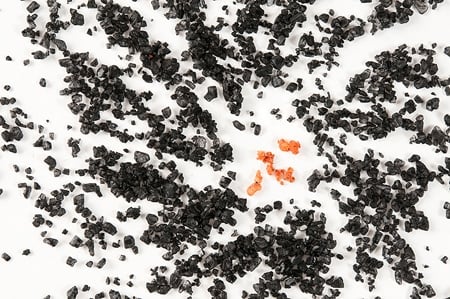
My next salts were Hawaiian, a black lava salt and one mixed with and orangey-red clay called alaea. These salts don’t taste much different from regular salt, but I like their ability to add interest and color to a plate: Both salts look great on contrasting food, especially white food. A little bright red alaea or black salt on a white cream sauce looks very cool.
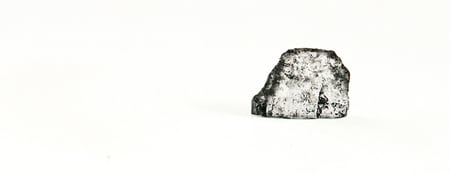
I also noticed something else about these Hawaiian salts: They were harder than regular salt, so they stayed crunchy longer.
I was perfectly happy with my little salt collection until I opened a book by Mark Bitterman called Salted: A Manifesto on the World’s Most Essential Mineral. I’d met Mark before, in Portland, where he runs a remarkable shop called The Meadow. The Meadow is home to perhaps the world’s greatest collection of salts, and Bitterman’s book is both a walk through these salts and is a call to arms for cooks to take this element more seriously in the kitchen.
Apparently what I did not know about salt could indeed fill a book, and I read Bitterman’s tome from cover to cover. Afterwards, I immediately bought several more salts to play with:
- A French fleur de sel de Camargue, which was wet and coarse
- Sel Gris, which is another French coarse sea salt that is slightly gray from clay deposits
- An Italian fiore di sale which is a fine-grained fancy finishing salt
- A salt lightly smoked with wood from Chardonnay wine barrels
- A pink flake salt, whose grains looked like little pyramids
- And a large container of fine-grain sea salt from Trapani, in southern Italy. Bitterman said this is a good everyday salt to replace kosher.
I messed around with all these salts for several months. Having done so, I have become a convert to Bitterman’s way of thinking. Salt matters. A lot.
Yes, it is true that sodium chloride is roughly 98 percent of all salts. But that 2 percent cancreate discernible differences in flavor. Bitterman does get carried away with his descriptions of the various salts — he describes the smoked Chardonnay salt as having a flavor that is “oak with grass and spice.” Uh, not so sure about that. But it is a wonderfully subtle smoked salt that I find far more useful tool than the salish, which is a sledgehammer.
As for that fiore di sale from Cervia, Bitterman says it is sweet and almost fruity — and I have to say I agree with him. Frankly, I was shocked to pick up something other than saltiness in an unflavored salt. Something in this Italian salt that is not sodium chloride is giving it this flavor. What it is, I don’t know, but fiore di sale from Cervia has become my go-to salt for fancy or delicate dishes.
Bitterman’s book includes another revelation: The importance of water in your salt. Yes, water. Good salt, apparently, has a relatively high water content. Several of the salts I received from The Meadow were practically slushy. Water content matters because without it, the salt attacks the surface moisture of the foods its put on and dries them out. This is great with charcuterie, but not so great on, say, the skin of a partridge.
Bitterman’s book includes a recipe for salt-crusted partridge, bless his heart, so I decided to conduct an experiment: I’d encase one bird in kosher salt, the other in sel gris, as Bitterman suggests.
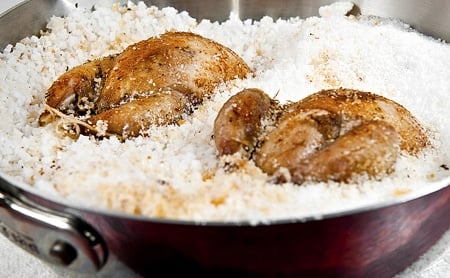
It worked. The bird baked in the sel gris crust came out moister and, oddly, the skin was crispier than the one cooked in kosher salt. It was not wishful thinking, either. The difference was obvious. Now sel gris is not as cheap as kosher salt, but it’s nothing like the expense of a good finishing salt. I reckon the salt crust on the partridge cost me about $2, which isn’t so bad.
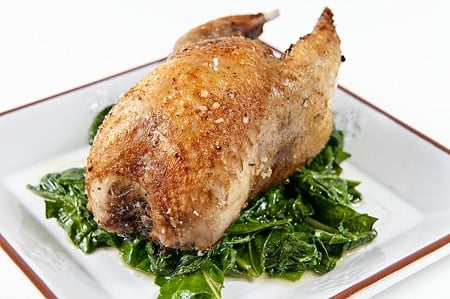
But the varying flavors in all these fancy salts are subtle; I suspect only an expert like Bitterman can discern most of them. Flavor, however, is not the greatest contribution a finishing salt brings to a dish: it’s texture. If I put three different salts, each with a different degree of coarseness, on three identical steaks, you would be amazed at the differences.
- A coarse, crunchy fleur de sel will add a muscular bite to the flavor of the meat. It is primal, and screams of the outdoors.
- Flake salt crackles in your mouth when you eat it, creating the impression of a brittle, crunchy crust on the meat. It’s a little bit more refined a feeling, like remembering campfire eating without actually being outdoors.
- Fine grain sea salt, like the Italian fiore di sale, will rest on your steak like snow on a sunny day. It will offer just the slightest zing of saltiness as it dissolves. This is white-linen dining, folks.
Bitterman offers a salt for every occasion, from salads (flake salts) to fish (Japanese salts) to pork (Hawaiian black lava salt). He even offers some salts to avoid, notably the mass-produced “sea salt” extracted from the salt flats of San Francisco. He describes the flavor as “flat dullness.” As to what foods this salt matches well with? “None.” Ouch.
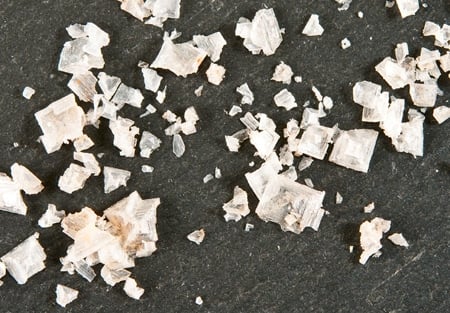
So what’s the bottom line here? Salt is an easy way to elevate your cooking, and every decent cook should have several in the kitchen at all times.
Although Bitterman would cringe, I still recommend using kosher salt when you are using lots of it, such as blanching vegetables or cooking pasta. The exception to that would be when you bake meats or vegetables in salt; then use sel gris.
Use a smoked salt to add a rustic flavor to otherwise fancy dishes. Smoked salt is fantastic with wild game, fatty fish, fried potatoes, even chocolate ice cream. I use two kinds: Salish, for a seriously smoky flavor, and the smoked Chardonnay salt for delicate dishes.
Buy two finishing salts, one coarse and one fine. You can’t go wrong with the fiore di sale from Cervia for a fine salt, and the various French fleur de sels are great for coarse salt.
Finally, I’d have a flake salt kicking around — especially if you are into salads. Maldon Sea Salt is a good choice. This salt will liven up all sorts of leafy greens, and it is wonderful on delicate fish, melons, even foie gras.
Best part? These fancy salts won’t ever go bad, so you can use them for years. After all, salt is just a rock. Remember?




I must admit, I’m a salt snob. I’ve bought a number of things from your friend at ‘The Meadow’ and love them all. I’ve used the black sulpherous salt in tofu as a sort of ‘fake’ egg salad for my vegan friends and love any of the pink and grey sea salt. I also have several salt blocks which are terrific for cooking on.
Great article, as usual!
We’ve been harvesting salt on Moloka’i for a few years now. Mid summer the seawater sits on the lava rocks on the ocean, dries out in the scorching sun, and leaves beds of wet salt. We scoop it up, lay it out over night, then vac seal it in the morning. It’s strong, sometimes perfectly fishy, and wonderful.
I’m convinced…
Thank you for this balanced and thoughtful article on the proper use of specialty salts Hank. Dropping handfuls of grey salt into pasta cooking water is rediculous. Bitterman goes way overboard in his condemnation of “mass produced” salt. So much so that I do not think he is doing “artisanal” salts any favors. He comes off as a bit pompous honestly (he was a guest on Splendid Table a few months back). Those interested in specialty salts should just read your entry instead. Kosher salt in particular is great for 99% of the applications. I only use fleur de sel or Maldon as a last minute finishing salt and mostly to add textural interest (on a sliced tomato for example). I love the idea of the black lava salt on white dishes though and will seek it out.
Hank,
great post.
this brought back to mind my first culinary class and salt tasting day.
all of it just tasted like, well…salt and I thought the whole exercize was
pretty dumb. (I still believe that the chef’s at the school over salted everything.)
now, as I cook for myself, and family and friends, I like playing with the different salts. love the Hawaiian’s for the colors. love the smoked on a nice salmon steak.
Awesome!
Ok, if you swear there’s a real difference, I will experiment with salts. I am right where you were a couple years ago – kosher salt is better because the flakes are shaped differently, but what could possibly be different when salt is almost entirely sodium chloride? Good point that it doesn’t go bad, so I can slowly buy salt that’ll last for years. Thanks 🙂
Hank
Let me join the chorus of unbelievers you have swayed, you’ve got me intrigued
What is it that makes the black one black?
SBW
Hank. Have you ever tried Korean Bamboo Salt?
Kate: I do know some people who smoke their own salts, so I know it can be done. Not exactly sure how, though.
Stanley: Bitterman’s book has some good things to say about Spanish sea salts. Basically they tend to be of high quality, like the French and Italian ones.
Andy: I like cooking on the Himalayan salt more than using it in granular form. I have a few salt blocks from The Meadow I need to use more often.
Joshua: Sounds like a plan.
JR: I don’t even eat popcorn and that sounds good!
I have always been attracted to the colors, the shapes, the translucency of the crystals of different salts, but like many, dismissed using them as pure luxury and snobbishness. I am glad for this post. Now I don’t have to experiment with the expensive lovelies – I will trust you and your experience:)
I am actually looking forward to trying these smoked salts as soon as I talk myself into buying them. Thanks!
I have used various salts for different results for years. At the moment one of my favourites is Mount Zero – Pink lake Salt, hand harvested & air dried. And profits go to indigenous community that harvested it. Whats not to like?!
I love salts, I find it nearly impossible not to indulge in varieties or blends I come across. They can be used in so many ways the possibilities are endless. A porcini salt to frame a mushroom risotto, a saffron salt to accent a paella, a blend of celtic sea salt with fresh herbs to crust a roast, or a simple black salt to finish a dish and add some color. I almost need another drawer in my kitchen to house my salts….and let’s not forget the salt cooking block.
The other night I took some popcorn, tossed it with a warmed caramel and hazelnut spread (nutella), added some smoked salt and put it all on top of vanilla ice cream. It was gluttonous, but delicious.
What an interesting post. I’m going to put a touch of that smoked salt on a couple of teal I plan to roast. Wish me luck.
I, too, was dismissive of fancy-dancy salts until a friend gave me some 4oz packets she picked up from a food dealer buddy. I have always been one who shunned away from salt in favor of pepper or some other flavor but I now recognize the importance of good salt in making a dish “pop”. Formerly, I used salt mainly in soups or when chemically required (as in baking). Now, my household goes through it like any other seasoning. I love to use grey or green sea salt on popcorn and oak wood-smoked salt from Oaxaca (relatively cheap in the bulk bin at my local grocery) is my secret weapon in barbecue sauces and jerky. Not all rare/expensive salt is worth it though. I tried some Himalyan pink salt and found it to have a strong “gypsum” flavor. I think it could easily ruin a dish and too much might make you queasy. The lesson I learned is that many mineral salts contain high level of other salts, not just NaCl. Maybe good for preserving meats but not so good on popcorn. Kosher is definitely the best all-around salt (hard to beat the price too) but I could eat Irish green with a spoon.
Superb article.. been using sea salt from Spain. Any comments?
Great post! I got a bottle of pink salt and another gray salt a while back and I haven’t been sure of how to use them. Thanks for the tips.
I had never thought about salt before. Thanks for this!
Okay, having read your post, I’m marginally less skeptical about fancy salts. My cheapness, however, remains completely unaffected. I won’t spring for expensive salts. I’m happy with kosher, and would like to remain happy with it. That said, ever tried smoking your own salt? I wonder if kosher salt could be smoked in an open pan. One might be able to custom smoke different salts with different woods, or different combinations of woods. Hmm…
Great article! I hadn’t looked as closely at salts myself either. This is definite excellent food for thought.
I see some salt experimentation in my future!
Thank you!